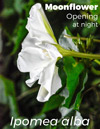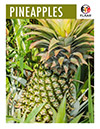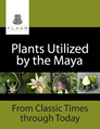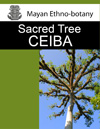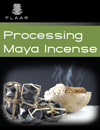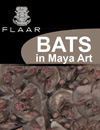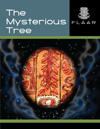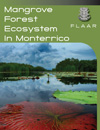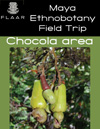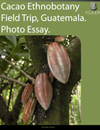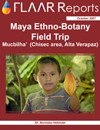As a student in the 1960's, I was aware that most traditional monographs on Mayan food focused on "maize, beans, and squash." Then came a deluge of helpful articles and dissertations on the belief that maize-beans-squash focus was totally incorrect: the new slogan was root crops, or ramon nuts. Today people talk about Chaya also. Plus dozens of other articles trying to show how inaccurate the maize-beans-squash focus of early Carnegie Institution of Washington and other scholars before the 1960's.
When I started getting serious about learning about Mayan agriculture and food, I did research for several years (keeping in mind I had already lived in El Peten 6 years by 1975, and the first of these years was at age 19). So even before I really focused on plants full time, I had already lived off Maya gardens on the shores of Lake Yaxha, El Peten.
One by one I re-read the articles and books which debunked the focus on maize, beans, and squash. Take root crops for example: I even found in my own studies that Bennett Bronson did not even list all the root crops the Maya really raised and ate! So, on paper, I found even more evidence to support one theory after another.
I am keenly interested in home gardens, especially the fruit trees which grow around Mayan houses. Most of these would not be found in a list of food products since most Neotropical fruits bruise easily or rot so quickly after picking they would not be viable trying to sell them in a distant market.
But as I spent more time out in remote areas, we hiked through countless milpas. I enjoy exploring caves since as a child in the Missouri Ozark Mountains my brother and I spent many weekends in the caves on our family farm. To reach caves in Alta Verapaz you always have to hike through mile after mile of milpas. So I have a relatively first-hand, in-person understanding what is in a milpa.
 |
|
A type of Beans sold at local markets.
|
Plus we have found several really hospitable local people in many towns who take us out into their milpas at different seasons of the year. So month by month, milpa by milpa, eco-system by eco-system, I can't help but notice that MAIZE is the #1 crop by far, followed by beans and squash. In our own office, maize, as tortillas, is still the primary food preferred by our Kaqchiquel and K'ekchi' assistants.
So after decades of looking at the several HUNDRED other foods available, and after spending years making a list of every single edible food of the entire Maya area, I must admit that maize keeps popping up (pun intended, though popcorn is mainly in the modern movie theatres, not out in the slash-and-burn milpas of Guatemala.
Despite the obvious primacy of maize, beans are important in Maya diet
When driving through Guatemala (or rural areas of other adjacent countries) you see maize fields everywhere. Beans (frijoles, (Phaseolus species) are not as noticeable. However after the maize cobs have been harvested, and the top of the plants bent down, you notice the bean vines more than before.
But to see an entire field solely of beans, these are not as common (and may be a more modern style of mono-culture). Where I see beans are primarily as vines wrapping around the maize stalk, in areas of slash-and-burn agriculture.
 |
|
A type of Beans sold at local markets.
|
Black beans are the most common in Guatemala, but other colors are available
When I eat my meals, for decades, 95% of the beans served to me in my own house are black beans. In restaurants (in Guatemala), at least half of the beans are also black. But when you go to nearby countries, often you get beans of other colors.
The red, white, and other color beans are also present in the markets of Guatemala. So people do use beans of other colors. But I must admit that the black bean is what I am fully content with, unless I ask for chile con carne, which is a Tex-Mex concoction with yummy reddish beans.
 |
|
Diferent type of beans, as you can see, they vary in color, but are very similar in shape.
|
In our ethnobotanical garden we have two rare kinds of beans
Since my own taste sensors prefer black beans, I don't pay as much attention to other varieties. But the local people who take care of my ethnobotanical garden, they discretely plant several other bean species so they can have a free meal out of the garden (which we allow them; we also raise bananas, which although are not native, are very popular, especially since we let all the staff eat them at no cost and even take bananas back home with them).
This week (December 2014) much to my surprise, the K'ekchi' gardener came with three kinds of bean pods. Plus there was a fourth species or variety of bean pod still on the vines. So just in a simple garden around our house we have four kinds of beans (none of which are frijol negro because these you can buy at any supermarket within a two-block walk).
 |
|
Beans with small seed, called "rice beans" because a fleck of white on the bean is rice sized and shape. Kakchiquel and K'ekchi' staff with Dr Nicholas Hellmuth in their kitchen (research) ethnobotanical garden, 1500 meters elevation, Guatemala.
|
K'ekchi' (Q'eqchi') Mayan names for beans
Chux, white flowered beans (or Ch'ux)
Lol (Q'ienk), red flowered beans, Phaseolus coccineus
Mis Q'ienk, Gato frijol, cat's beans, with yellow flowers
Nun (Q'ienk), green, beans, Phaseolus coccineus
There are many spellings for each word, depending on whether you are a North American ethnobotanical linguist (Mike Wilson, PhD on K'ekchi' ethnobotany) you spell the word quenk'. Our gardener, a native Q'eqchi' Mayan speaker , spells it another way, and a university trained agronomist, also a Q'eqchi' speaker, spells it Q'ienk. I would estimate in Belize it may be spelled differently again. This is natural, since scholars use their own system for spelling Mayan languages. And these systems change every decade or so.
Considering how many species of beans were known by our Q'eqchi' gardener from Senahu, I am surprised that a PhD ethnobotanist found only 75% of them (though this is better than most other treatises on Mayan agriculture where they discuss beans).
I would expect that there are many variable spellings for these beans; these are the names given by agronomist Mauro Gulielmo García, who lives in Cobán, Alta Verapaz, Guatemala, and who speaks K'ekchi'.
We raise the beans with red flowers and the variety with yellow flowers at 1500 meters elevation. The beans flower and provide beans (which our K'ekchi' gardener really loves).
Since I could not quickly find any treatise on slash-and-burn agriculture which provided an easy to understand tabulation of the different beans of Maya agriculture, I spent several nights on the Internet and was able to develop this tabulation. I need to do a lot more research, need to speak to more Q'eqchi' people, and would like to raise the missing fifth species so I can photograph the flowers also.
We will be issuing a bibliography on Phaseolus species and varieties found in Mayan areas as soon as we have funding to hire a capable student to assist on typing up the bibliography and putting it in proper format. But in the meantime we would like to provide the following preliminary tabulation.
|
Botanical name |
Common name in English |
Local name(s) in Spanish |
Q'eqchi' Mayan |
What color is the flower |
|
Phaseolus acutifolius |
Tepary bean, |
piñuelero bean |
|
|
|
Phaseolus coccineus |
(scarlet) Runner bean |
|
Nun (Q'ienk), |
|
|
Phaseolus lunatus |
Lima bean |
|
|
|
|
Phaseolus polyanthus or synonym Phaseolus dumosus |
Year bean, |
Piloya, ayocote. |
|
|
|
Phaseolus vulgaris |
Common bean |
|
|
|
It would be really a useful contribution to Maya studies if different students could do at least two separate dissertations on beans
- beans in Maya slash-and-burn agriculture, tabulated comparisons across Mexico, Guatemala, Belize, and Honduras
- Biological, Ethnobotanical and linguistic study of beans in slash-and-burn agriculture of the approximately 21 Mayan languages of Guatemala plus the several Mayan languages of Mexico, plus studies in Belize and Honduras.
It would be tough to do seriously in-depth fresh field research in all these languages unless a student is really motivated to produce a dissertation that will be cited for many decades. So I have suggested two different dissertation topics. Both would require being in all pertinent eco-systems and with all Mayan language groups.
Now we can see why there is no such dissertation (or if so, it is not cited often enough for me to have found it yet).
Pictures of Mayan food
We have been photographing raw beans in markets throughout Guatemala for decades. Gradually we will be considering photographing the actual food (cooked and being eaten in real homes). The people on my staff say that these beans (most of which I have never seen before the gardener harvested them) are very tasty.
More on Mayan homes and house architecture in preparation
Studying plants and food is one aspect of what is helpful to bring knowledge to the world of the remarkable ability of the Mayan people to have settled and survived in their present area for several thousand years. Another aspect are the houses in which these people lived in the remote areas. These houses are 100% made from plants, so I am also interested in the architecture of traditional Maya dwellings.
Since architects are synonymous with the Hellmuth family name, I dutifully studied architecture at Harvard. After taking an internship at the Tikal archaeological park in 1965, I returned to college and switched to archaeology and anthropology. Today, 50 years later, I am still interested in architecture, but of the Maya, and specifically with their wooden house architecture.
So we will be showing more about Mayan home life in future additions. We already cover thatch and grass roofing of homes of the Q'eqchi' (K'ekchi') Mayan people of Alta Verapaz and Izabal.
Updated December 15, 2014
First posted December 5, 2014
After our gardener brought seeds to our photo studio and surprised me with how many bean species were growing in our garden (which is a total Neotropical selva, requiring a machete to get through it, so often you can't see more than a meter or so in front of you). I find rectangular or organized gardens a tad dull and boring; I prefer totally wild random plants in my garden.



